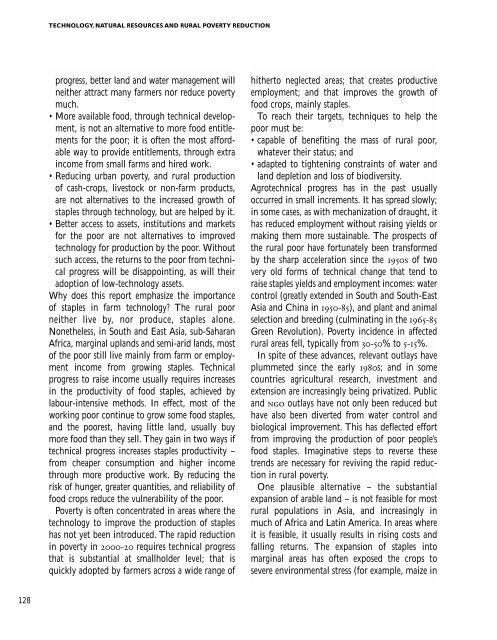English - IFAD
English - IFAD
English - IFAD
Create successful ePaper yourself
Turn your PDF publications into a flip-book with our unique Google optimized e-Paper software.
TECHNOLOGY, NATURAL RESOURCES AND RURAL POVERTY REDUCTION<br />
progress, better land and water management will<br />
neither attract many farmers nor reduce poverty<br />
much.<br />
• More available food, through technical development,<br />
is not an alternative to more food entitlements<br />
for the poor; it is often the most affordable<br />
way to provide entitlements, through extra<br />
income from small farms and hired work.<br />
• Reducing urban poverty, and rural production<br />
of cash-crops, livestock or non-farm products,<br />
are not alternatives to the increased growth of<br />
staples through technology, but are helped by it.<br />
• Better access to assets, institutions and markets<br />
for the poor are not alternatives to improved<br />
technology for production by the poor. Without<br />
such access, the returns to the poor from technical<br />
progress will be disappointing, as will their<br />
adoption of low-technology assets.<br />
Why does this report emphasize the importance<br />
of staples in farm technology? The rural poor<br />
neither live by, nor produce, staples alone.<br />
Nonetheless, in South and East Asia, sub-Saharan<br />
Africa, marginal uplands and semi-arid lands, most<br />
of the poor still live mainly from farm or employment<br />
income from growing staples. Technical<br />
progress to raise income usually requires increases<br />
in the productivity of food staples, achieved by<br />
labour-intensive methods. In effect, most of the<br />
working poor continue to grow some food staples,<br />
and the poorest, having little land, usually buy<br />
more food than they sell. They gain in two ways if<br />
technical progress increases staples productivity –<br />
from cheaper consumption and higher income<br />
through more productive work. By reducing the<br />
risk of hunger, greater quantities, and reliability of<br />
food crops reduce the vulnerability of the poor.<br />
Poverty is often concentrated in areas where the<br />
technology to improve the production of staples<br />
has not yet been introduced. The rapid reduction<br />
in poverty in 2000-20 requires technical progress<br />
that is substantial at smallholder level; that is<br />
quickly adopted by farmers across a wide range of<br />
hitherto neglected areas; that creates productive<br />
employment; and that improves the growth of<br />
food crops, mainly staples.<br />
To reach their targets, techniques to help the<br />
poor must be:<br />
• capable of benefiting the mass of rural poor,<br />
whatever their status; and<br />
• adapted to tightening constraints of water and<br />
land depletion and loss of biodiversity.<br />
Agrotechnical progress has in the past usually<br />
occurred in small increments. It has spread slowly;<br />
in some cases, as with mechanization of draught, it<br />
has reduced employment without raising yields or<br />
making them more sustainable. The prospects of<br />
the rural poor have fortunately been transformed<br />
by the sharp acceleration since the 1950S of two<br />
very old forms of technical change that tend to<br />
raise staples yields and employment incomes: water<br />
control (greatly extended in South and South-East<br />
Asia and China in 1950-85), and plant and animal<br />
selection and breeding (culminating in the 1965-85<br />
Green Revolution). Poverty incidence in affected<br />
rural areas fell, typically from 30-50% to 5-15%.<br />
In spite of these advances, relevant outlays have<br />
plummeted since the early 1980s; and in some<br />
countries agricultural research, investment and<br />
extension are increasingly being privatized. Public<br />
and NGO outlays have not only been reduced but<br />
have also been diverted from water control and<br />
biological improvement. This has deflected effort<br />
from improving the production of poor people’s<br />
food staples. Imaginative steps to reverse these<br />
trends are necessary for reviving the rapid reduction<br />
in rural poverty.<br />
One plausible alternative – the substantial<br />
expansion of arable land – is not feasible for most<br />
rural populations in Asia, and increasingly in<br />
much of Africa and Latin America. In areas where<br />
it is feasible, it usually results in rising costs and<br />
falling returns. The expansion of staples into<br />
marginal areas has often exposed the crops to<br />
severe environmental stress (for example, maize in<br />
128
















